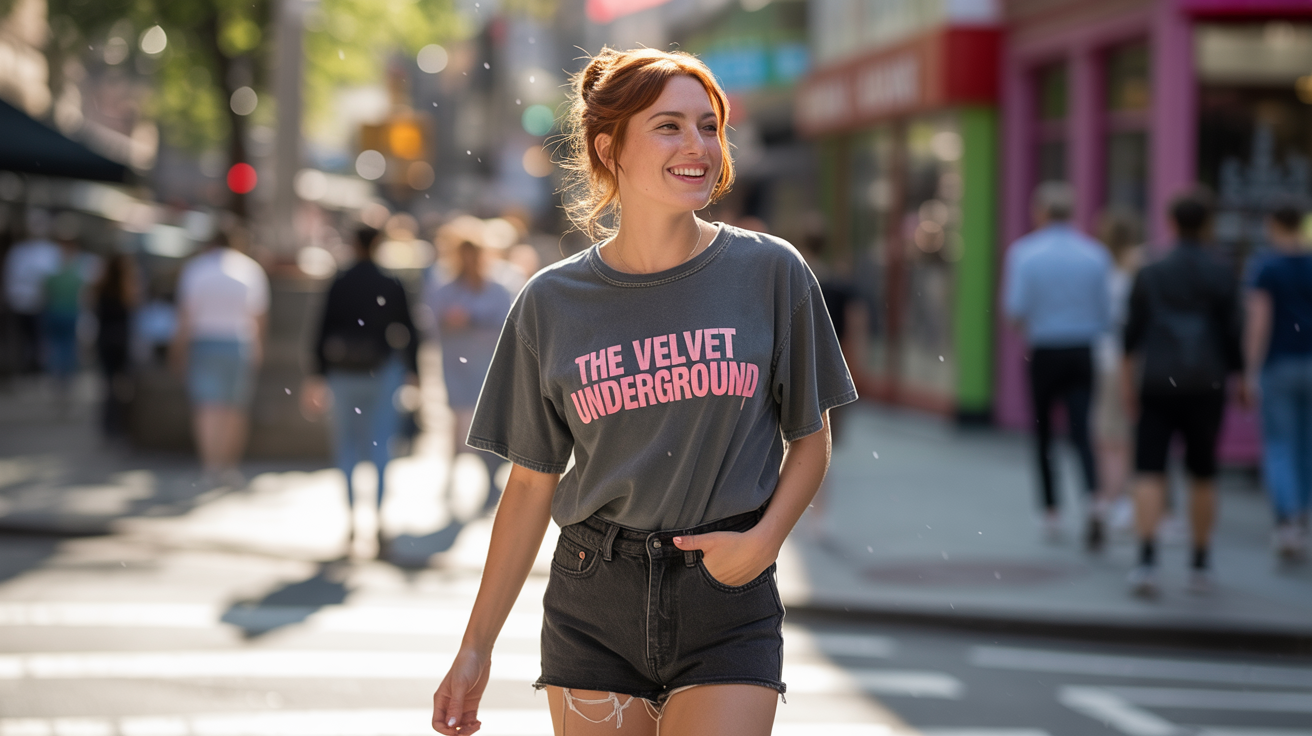T-shirts are more than just casual wear; they’re the ubiquitous canvas of personal style, the dependable workhorse of almost every wardrobe. They offer unparalleled comfort, remarkable versatility, and the unique ability to be dressed up or down with effortless ease. Yet, with an ocean of options flooding the market, the simple act of choosing the right T-shirt and styling it to truly stand out can feel surprisingly daunting. It’s not merely about grabbing the first tee you see; it’s an art form that involves a keen understanding of fit, fabric, color, and how these elements converge to express your unique personality and command attention.
The Absolute Foundation: Mastering the Fit – Your First Step to Standing Out
Let’s be unequivocally clear: the single biggest style misstep people make with T-shirts is wearing the wrong size. A perfectly fitting T-shirt instantly elevates your entire appearance, making you look more put-together, even if you’re just rocking jeans and sneakers.
- Shoulders are Key: This is your primary indicator. The shoulder seam should align precisely with the outer edge of your shoulder bone. If it sags down your arm, the shirt is too big. If it pulls tightly or creates a ripple around your armpit, it’s too small. Getting this right ensures a clean, sharp silhouette.
- Torso Taper: Your T-shirt should gently skim your body without being either skin-tight or excessively baggy. You should be able to pinch approximately one to two inches of fabric on either side of your waist when standing naturally. Too much extra fabric adds bulk and looks sloppy; too little restricts movement and can be unflattering.
- The Goldilocks Length: For most casual wear, the hem of your T-shirt should ideally fall around the middle of your fly or just barely cover your belt. This length looks proportionate and prevents your torso from appearing either too long or too short. If you intend to tuck it in, ensure there’s sufficient length so it stays neatly tucked without coming undone with every movement.
- Sleeve Placement and Width: The sleeves should typically end around the mid-bicep. If they extend too far down your arm, they can make your arms look shorter and the shirt appear ill-fitting. Conversely, sleeves that are too short or tight can feel constricting and unflattering. The width should allow for comfortable movement without gaping or squeezing.
Pro Tip for Perfect Fit: Never rely solely on the size label! Sizing varies wildly between brands. Always try on T-shirts before purchasing them if you can. If shopping online, meticulously consult size charts and read customer reviews for insights into how a particular brand’s sizing runs. Don’t hesitate to measure one of your best-fitting T-shirts and compare those measurements to the online chart.
Fabric Matters: The Unsung Hero of Comfort, Durability, and Drape
Beyond fit, the fabric of your T-shirt dictates its tactile feel, how elegantly it drapes over your body, and crucially, its longevity. Investing in quality fabric is investing in your comfort and your long-term style.
- Cotton: The Ever-Reliable Staple:
- Standard Cotton: Breathable and affordable, perfect for everyday wear. However, quality can vary significantly.
- Combed Cotton: A step up from basic cotton. It undergoes a process that removes short fibers and impurities, resulting in a softer, smoother, and more durable fabric that’s less prone to pilling.
- Ring-Spun Cotton: Offers a softer feel than standard cotton due to the way the fibers are spun, creating a finer, stronger yarn.
- Pima or Supima Cotton: These are the crème de la crème of cottons. Derived from extra-long staple cotton fibers, they are renowned for their exceptional softness, lustrous sheen, superior strength, and remarkable resistance to fading, stretching, and pilling. A Pima or Supima cotton T-shirt feels luxurious against the skin and lasts considerably longer.
- Organic Cotton: Grown without harmful pesticides or synthetic fertilizers, making it an eco-conscious and hypoallergenic choice. It often feels incredibly soft.
- Blends: The Best of Both Worlds:
- Cotton-Polyester Blends: A popular choice that combines cotton’s breathability and softness with polyester’s durability, wrinkle resistance, and moisture-wicking properties. Often used for athletic wear or T-shirts that need to hold their shape well.
- Cotton-Rayon (or Tri-Blends including Spandex): These blends often offer an incredibly soft, lightweight, and slightly stretchy feel with an excellent drape. Rayon (or viscose) adds a silky texture, while spandex provides elasticity for comfort and shape retention. Ideal for a slightly more elevated casual look.
- Linen: The Breathable Choice for Warm Climates:
- Linen T-shirts are highly prized for their exceptional breathability and moisture-wicking abilities, making them perfect for hot and humid weather. They possess a distinctive, textured look and a naturally relaxed drape. While they wrinkle easily, this is part of their inherent charm and laid-back appeal.
- Merino Wool: The Surprising All-Rounder:
- Don’t be deterred by the “wool” in its name! Merino wool is an incredibly fine, soft, and lightweight fiber that feels far from scratchy. It’s a natural wonder, offering excellent temperature regulation (keeping you cool in summer and warm in winter), natural odor resistance, and moisture-wicking properties. It’s an outstanding choice for travel, layering, or active lifestyles due to its performance benefits and luxurious feel.
Consider the occasion: For your everyday errands, a high-quality combed cotton is perfect. For a gym session, opt for a performance blend. When aiming for a slightly more sophisticated casual outfit, a Pima cotton, linen, or merino wool T-shirt will elevate your look significantly.
Color Psychology: Making a Statement Without Saying a Word
Colors are powerful communicators, capable of evoking emotions and significantly influencing how you’re perceived. Choosing the right hue can make your T-shirt an integral part of your personal branding.
- The Indispensable Neutrals (White, Black, Gray, Navy): These are the cornerstones of any versatile wardrobe. They are incredibly adaptable, forming the bedrock upon which countless stylish outfits can be built. Neutrals allow other elements of your outfit – perhaps a statement jacket, vibrant shoes, or a unique accessory – to truly pop and shine.
- Earth Tones (Olive Green, Khaki, Rust, Brown, Terracotta): These colors exude a grounded, natural, and approachable vibe. They pair beautifully with other neutrals and create a cohesive, understated yet stylish palette that feels organic and inviting. Perfect for a rugged or relaxed aesthetic.
- Vibrant Hues (Crimson Red, Royal Blue, Emerald Green, Sunny Yellow, Electric Orange): These are your tools for making a bold statement and injecting undeniable personality into your look. They’re fantastic for casual social outings, creative environments, or any time you want to genuinely stand out from the crowd and command attention. Use them strategically as a focal point.
- Pastels (Sky Blue, Mint Green, Lavender, Pale Pink, Butter Yellow): Offering a softer, gentler, and often more youthful aesthetic, pastels are perfect for spring and summer months. They provide a subtle, understated pop of color that’s less intense than vibrant hues but still adds interest.
Strategic Color Matching Tips:
- The Color Wheel is Your Friend: Use a basic color wheel for inspiration and guidance.
- Analogous Colors: These are colors that sit next to each other on the color wheel (e.g., blue and green, yellow and orange). Combining them creates a harmonious, visually pleasing, and sophisticated look.
- Complementary Colors: These are colors directly opposite each other on the color wheel (e.g., blue and orange, red and green, yellow and purple). Pairing them creates a vibrant, high-contrast, and dynamic look that immediately catches the eye. Use them when you want to make a strong visual impact.
- Monochromatic Outfits: This involves using different shades, tints, and tones of a single color (e.g., a navy T-shirt with light blue jeans and dark blue sneakers). This approach is inherently sophisticated, elegant, and often creates an elongating effect, making you appear taller and slimmer.
Styling Your T-Shirts: Beyond the Basics to Stand Out
This is where your fashion creativity truly comes alive! A humble T-shirt can serve as the stylish nucleus for an almost infinite array of sophisticated and eye-catching outfits.
- The Elevated Casual Masterpiece: Move beyond just “jeans and a tee.” Pair a premium quality, impeccably fitting T-shirt (think Pima cotton or a quality blend in white, black, charcoal, or navy) with your favorite, well-fitting dark wash or slim-fit jeans and pristine, stylish sneakers (perhaps classic leather instead of canvas). The key here is the quality of each component and its perfect fit.
- Smart Casual Reinvention: This is where the T-shirt truly shines in versatility. Layer a structured blazer (unstructured for a more relaxed feel) or an unbuttoned, well-fitting overshirt (denim, flannel, or chambray) over a plain T-shirt. Complete the look with tailored chinos, smart dark wash jeans, or even lightweight wool trousers. Footwear choices like loafers, desert boots, or sleek leather sneakers instantly elevate this combination.
- Layering for Depth and Intrigue: T-shirts are the ultimate base layer. Wear one under a rugged denim jacket, a warm flannel shirt (worn open or buttoned), a classic leather jacket, a stylish cardigan, or even a lightweight knit sweater. This not only adds warmth and texture but also creates visual interest and depth, making your outfit look more thoughtfully constructed.
- Dressing It Up (Yes, Really!): For a contemporary, relaxed-yet-refined formal look, a high-quality, perfectly fitted T-shirt (especially in solid, neutral colors like white, black, or deep navy, and premium fabrics like Supima cotton or merino wool) can be worn under a well-tailored suit (particularly a summer-weight linen or cotton suit) or paired with sharp dress trousers and sophisticated loafers or dress shoes. This look works best for less traditional formal events or creative professional settings.
- The Power of Accessories: Don’t underestimate how the right accessories can transform a simple T-shirt outfit from mundane to magnificent.
- Watches: A well-chosen watch, whether classic leather or sporty, instantly upgrades your wrist game and adds a touch of sophistication.
- Necklaces: A subtle chain or a tasteful pendant can add a personal touch and visual interest around your neckline without overwhelming the outfit.
- Belts: A good quality leather belt not only serves a functional purpose but also acts as a unifying element, especially if your shirt is tucked in or partially tucked.
- Hats/Beanies: A stylish baseball cap, beanie, or even a fedora can inject personality and a cool, laid-back vibe.
- Footwear: Your shoes are critical! Clean, well-maintained, and stylish footwear (whether sneakers, boots, or dress shoes) can genuinely make or break your entire T-shirt ensemble. They are often the first thing people notice.
- Eyewear: Sunglasses or clear glasses can add an intellectual or cool edge.
T-Shirt Care: Ensuring Your Investment Lasts and Looks Its Best
Even the most thoughtfully chosen and impeccably styled T-shirt will fall flat if it isn’t cared for properly. Longevity and a perpetually fresh look depend on diligent maintenance.
- Always Read the Label: This isn’t just a suggestion; it’s a golden rule. Manufacturers’ washing instructions are tailored to the specific fabric composition and will help prevent shrinking, fading, and damage.
- Wash Cold, Protect Color: Washing T-shirts in cold water is highly recommended. It significantly helps prevent shrinking, minimizes color fading (especially for darker hues), and is more energy-efficient.
- Turn Inside Out: Before tossing them in the machine, turn your T-shirts inside out. This simple step protects any prints, logos, or intricate weaves from abrasion, reduces pilling, and helps maintain color vibrancy on the outer surface.
- Air Dry or Low Heat Tumble: High heat is the enemy of most T-shirt fabrics. It can cause irreversible shrinking, damage delicate fibers (like cotton and blends), and degrade elasticity. Whenever possible, air dry your T-shirts by laying them flat or hanging them on a padded hanger. If you must use a dryer, opt for the lowest heat setting and remove them while slightly damp.
- Fold, Don’t Always Hang (Especially for Knit Tees): While it’s convenient, hanging heavier knit T-shirts (like those made from thick cotton or wool) can cause the shoulders to stretch out and deform over time. For these, it’s often better to fold them neatly and store them in drawers. Lighter, more structured tees can be hung without issue.
Choosing and matching T-shirts is far from a trivial task; it’s an art form that, once mastered, empowers you to express yourself with unwavering confidence. By meticulously focusing on achieving the perfect fit, understanding the nuances of various fabrics, strategically experimenting with the psychology of colors, and cleverly mastering the art of layering and accessorizing, you can effortlessly transform this seemingly basic wardrobe staple into an incredibly powerful and dynamic tool for personal expression and making a lasting impression.
So, go ahead, elevate your T-shirt game, and truly shine with confidence, one perfectly styled and exceptionally chosen T-shirt at a time!



